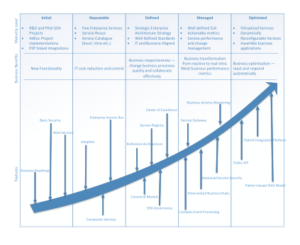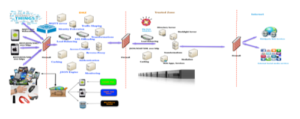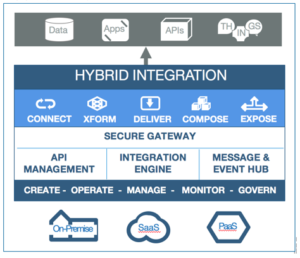Enterprise Architect
Background
Is your organization fit and ready to take on and implement an Enterprise Integration Strategy? How do you implement SOA Services, Service Security, Application Integration, APIs? Where do you start first? In a cloud and mobile first world, it is important for every organization to have a coherent and comprehensive enterprise integration strategy. Core foundational services, service security and governance frameworks will drive the enterprise adoption of the integration strategy, and will create a pathway for cloud and mobile adoption.
Components of Integration Strategy
Enterprise Integration Strategy consists of the following key components.
- Application Integration
- Data Integration
- Process Integration
- Cloud Integration
- Infrastructure & Security
The application, data and process integration strategies complement and enable each other to create a coherent and complete framework, supported by the on-premise and cloud infrastructures, with adequate security considerations. Here are some of the key aspects of each integration strategy component.
Application Integration
- SOA & Service Reusability
- Application Accessibility
- Managing Service Dependencies
- Decoupling Data and Application Silos
Data Integration
- Canonical Models
- Ensuring Data Quality
- Data Storage and Management (on-prem vs. cloud)
- Real-Time Data Replication and Federation
- Data Analytics
Process Integration
- Knowing and Documenting Business Processes
- Process Standardization and Avoiding Redundancy
- Process Visibility and Metrics
Cloud Integration
- Partner and Security Gateways
- Micro Services
- API Management
- SaaS Applications and On-prem Integration
Infrastructure & Security
- Identity and Access Management
- Securing Endpoints
- On-prem and Cloud Infrastructure (IaaS)
Integration Maturity Model
Integration maturity model gives you a template to understand the key elements of an enterprise services maturity. It is important to understand and analyze where you are currently, in order to know what and how to improve. The graphic below identifies the various maturity levels, areas to focus on as you move forward with your integration journey, along with the business benefits of each level.
Fit and Readiness Criteria
The goal of this fit and readiness criteria is to ensure success of various integration initiatives, and to elaborate on the holistic approach for Enterprise Integration.
To understand how fit an organization is, with respect to its integration strategy, you start off by evaluating the mission and the vision for the same. The key questions to ask are:
- Do we have an integration strategy?
- Is cloud integration a priority?
- Is mobile integration a priority?
- How important is real-time information?
The integration readiness criteria should be evaluated from the people, process and technology lens. Here are some key questions to consider.
People
- What is the organizational structure of the integration associates?
- Is there a good understanding of your business application APIs?
- Are the developers skilled in the cloud technologies?
Process
- What is your project funding model?
- Do you have a well-defined integration governance practice?
- How often is data manually assembled and reconciled, from various sources for enterprise reporting?
- Does your organization have extensive experience with vendor management?
Technology
- Is your organization consolidating the hardware footprint?
- Do you need to integrate on-prem and cloud applications?
- Do you anticipate significant increase in PaaS adoption?
- What percentage of your applications are custom built?
- Do you need to connect multiple sources to multiple targets?
- Will the same application interface need to be used across multiple integration scenarios?
- What is the trust level of your master data?
The Problem – Integration Landscape without a comprehensive strategy
As the integration evolves, organizations without a comprehensive strategy often tend to solve the need in isolation. For example, deploying point solutions for security, caching etc., or providing point to point connectivity for external partner integration and connecting to various cloud hosted solutions. Over time, this creates a scattered landscape with disparate disjointed solutions leading to loss of control and visibility. With the recent advancements in cloud technologies and the proliferation of SaaS/PaaS providers, the need for a comprehensive integration strategy has been accelerated.
The picture below provides a typical landscape of enterprise integration tooling, without a comprehensive strategy.
The Solution – Hybrid Cloud Integration
Hybrid cloud integration defines a comprehensive integration approach, which leverages the traditional investments in the on-premise and legacy applications, along with the new and innovative cloud technologies, so the organization can take full advantage of the new and changing enterprise landscape.
The key characteristics of the Hybrid Cloud Integration platform are:
- Integrate heterogonous applications and systems to communicate effectively
- Rapidly integrate SaaS and on-prem applications
- Expose traditional enterprise solutions as API
- Simplify development of rapidly scalable and responsive apps with messaging and micro services, and deploy them on-prem or to the public cloud
- Create encrypted gateways for secure access to on-prem API and data
Read Blog – Part 2: Enterprise Integration Strategy Roadmap
Please contact your Mainline Account Executive directly, or click here to contact us with any questions.





